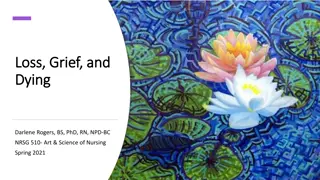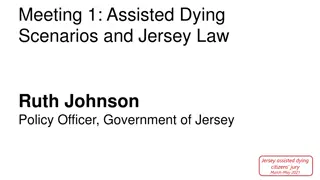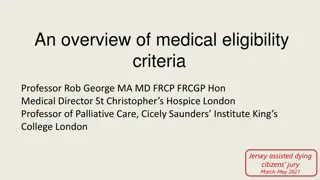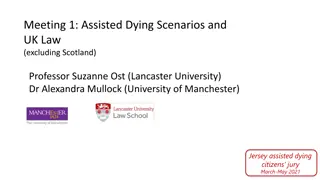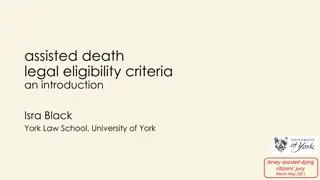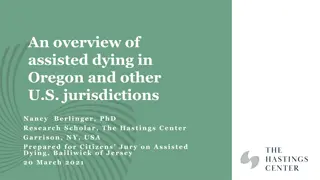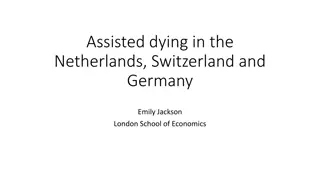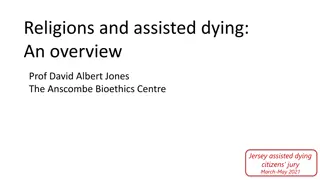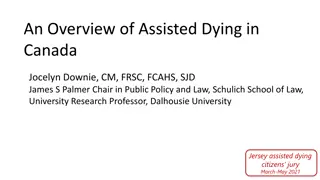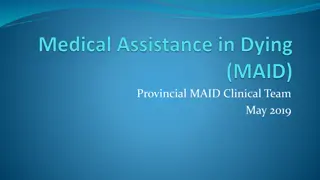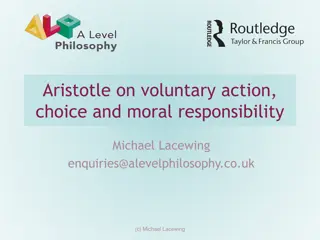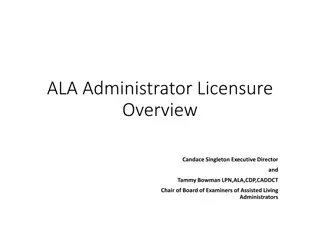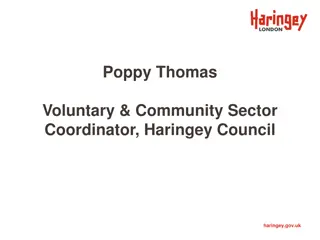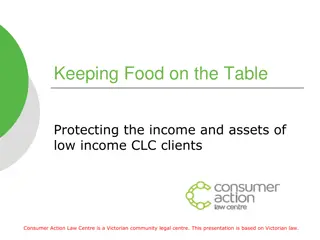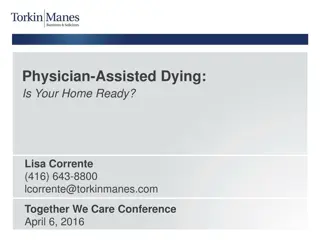Overview of the Voluntary Assisted Dying Act 2017 in Victoria
The Voluntary Assisted Dying Act 2017 was passed by the Victorian Parliament to provide legal requirements for voluntary assisted dying. It emphasizes respect for autonomy, informed decision-making, quality care, and cultural values. Eligibility criteria include being 18 years or older, an Australian citizen or resident, having decision-making capacity, and a terminal illness causing unbearable suffering. The act aims to balance choice with safeguards and regulatory processes to facilitate access to voluntary assisted dying.
Download Presentation

Please find below an Image/Link to download the presentation.
The content on the website is provided AS IS for your information and personal use only. It may not be sold, licensed, or shared on other websites without obtaining consent from the author. Download presentation by click this link. If you encounter any issues during the download, it is possible that the publisher has removed the file from their server.
E N D
Presentation Transcript
Voluntary Assisted Dying Act 2017 Introduction and overview
Introduction The Voluntary Assisted Dying Act 2017 was passed by the Victorian Parliament on 29 November 2017. The Act will commence operation on 19 June 2019. The Act followed two years of consultation and development, and reflects a balance between giving people choices at the end of their life and ensuring community safety. The policy in the Act is now settled and the focus has shifted to implementation of the Act.
Guiding Principles Every human life has equal value. A person s autonomy should be respected. Informed decision making. Quality care that minimises suffering and maximises quality of life. Therapeutic relationships be supported and maintained. Open discussions about death and dying. Conversations about treatment and care preferences. Genuine choice balanced with safeguards. All people have the right to be shown respect for their culture, beliefs, values and personal characteristics.
Voluntary Assisted Dying Act 2017 The Act sets out the legal requirements of voluntary assisted dying. Like any other clinical intervention, there are other considerations that will need to be addressed in practice. The Act provides for and regulates access to voluntary assisted dying in Victoria. It: establishes clear eligibility criteria steps through a detailed request and assessment process, including requirements for medical practitioners sets up a voluntary assisted dying permit process which authorises the prescribing and dispensing of voluntary assisted dying medication establishes the Voluntary Assisted Dying Review Board (Review Board) provides for a range of additional safeguards including medication monitoring, practitioner protections, offences, and a five year review.
Eligibility Criteria To access voluntary assisted dying, a person must meet all of the following eligibility criteria: be aged 18 years or more; and be an Australian citizen or permanent resident; and be ordinarily resident in Victoria for at least 12 months; and have decision-making capacity in relation to voluntary assisted dying; and be diagnosed with a disease, illness or medical condition that: is incurable; and is advanced, progressive and will cause death; and is expected to cause death within weeks or months, not exceeding 6 months (12 months for people with a neurodegenerative condition); and is causing suffering that cannot be relieved in a manner the person considers tolerable.
Request and assessment A person must make three separate requests. The formal process for requesting voluntary assisted dying is as follows: The person makes their first request to a medical practitioner (who becomes the co-ordinating medical practitioner if they accept). The person undergoes a first assessment by the co-ordinating medical practitioner. The person undergoes a consulting assessment by a consulting medical practitioner. The person makes a written request, which is signed by two independent witnesses. The person makes a final request to the co-ordinating medical practitioner. The person s final request must be made at least 9 days after the day on which they made their first request (exception if they are likely to die within that time).
If the person is eligible The co-ordinating medical practitioner applies for a voluntary assisted dying permit from DHHS to prescribe the voluntary assisted dying medication. This is an opportunity to ensure compliance with the request and assessment process. If the person is physically able to self-administer and digest the medication, the practitioner must apply for a self-administration permit. If the person is not physically able to self-administer or digest the medication, the practitioner must apply for a practitioner administration permit. Administration by a medical practitioner will only occur in very limited circumstances and will ensure those who are physically unable to self- administer are not discriminated against.
Information for health practitioners A health practitioner is not required to participate. A health practitioner must not initiate the discussion about voluntary assisted dying with a patient while providing a health service. There are protections for health practitioners and paramedics who act in good faith and in accordance with the Act. - This includes not providing life-sustaining treatment that has not been requested if they believe the person has accessed voluntary assisted dying. There are a range of offences, including offences to induce a request or self-administration, falsify records or make a false statement, and to provide or administer voluntary assisted dying medication without a permit.
Roles of medical practitioners The roles of the two assessing medical practitioners are clearly defined as the co-ordinating medical practitioner and the consulting medical practitioner. The co-ordinating medical practitioner supports the person, undertakes the first assessment, receives the requests, and is responsible for reporting. The consulting medical practitioner provides a consulting assessment. Both practitioners must ensure the person is properly informed of all treatment and care options and likely outcomes. Both practitioners must undertake independent assessments to form a view as to whether: the person meets the eligibility criteria; the person understands the information provided; the person is acting voluntarily and without coercion; and the person s request is enduring.
Which medical practitioners can participate? Only specialist medical practitioners (includes GPs) can conduct the assessment process and prescribe the medication. Between them, the co-ordinating and consulting medical practitioners must have: at least five years post-fellowship experience; and expertise and experience in the person s disease, illness or medical condition. Both medical practitioners must complete compulsory voluntary assisted dying training before conducting an assessment. Only co-ordinating and consulting medical practitioners are required to complete this training.
Medications and statewide pharmacy service A range of suitable medications are secured for use in Victoria. Medication protocols have been developed and will be made available to medical practitioners who have completed the voluntary assisted dying training. Permit applications and prescription will be required to occur in accordance with the medication protocols. The government has established a single statewide pharmacy service to dispense medications for voluntary assisted dying across Victoria. The statewide pharmacy service will assist co-ordinating medical practitioners in prescribing the voluntary assisted dying medications. It will also provide information and support to patients and contact persons about the use and return of medications.
Reporting requirements Mandatory reporting to the Review Board following the: first assessment (co-ordinating medical practitioner); consulting assessment (consulting medical practitioner); final review, following third request (co-ordinating medical practitioner); dispensing of the medication (pharmacist); disposal of the medication (pharmacist); and administration of the medication by a co-ordinating medical practitioner. Reporting forms are detailed in the Schedule to the Act.
Role of health services Health services must decide their level of participation in voluntary assisted dying. Regardless of whether a health service provides voluntary assisted dying it must be prepared for the commencement of the Act. Things to consider include: how will staff respond to questions and requests for information? how will staff be supported in managing these requests? if voluntary assisted dying will not be provided, will patients be referred? how will staff be educated and supported if voluntary assisted dying will be provided at a health service?
Resources Model of care pathways and other health service resources Guidance for health practitioners Community and consumer information Voluntary assisted dying training Statewide pharmacy service Medication protocol Care navigator support service Taskforce monthly newsletter https://www2.health.vic.gov.au/hospitals-and-health-services/patient- care/end-of-life-care/voluntary-assisted-dying


